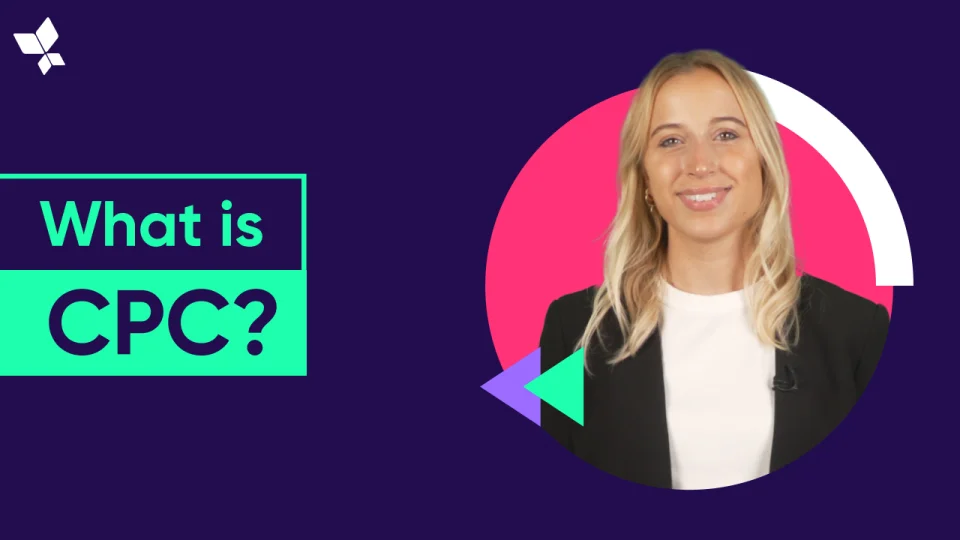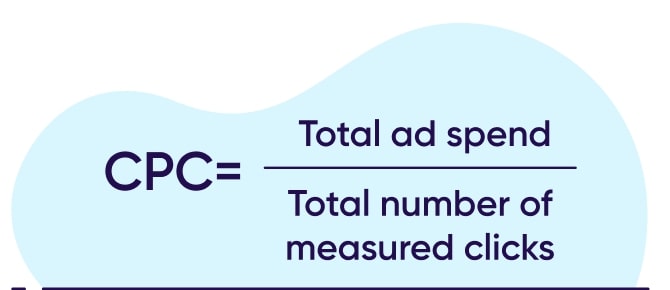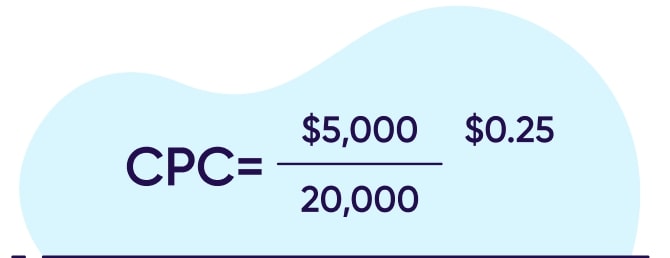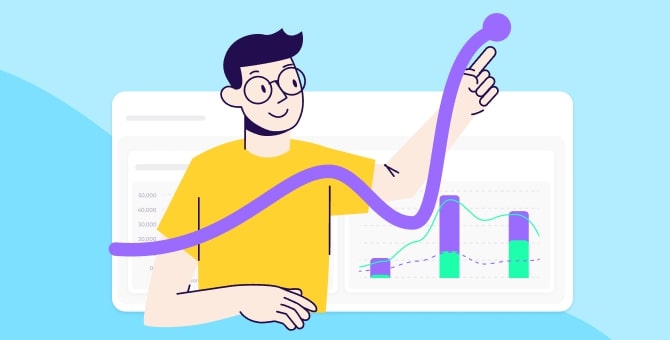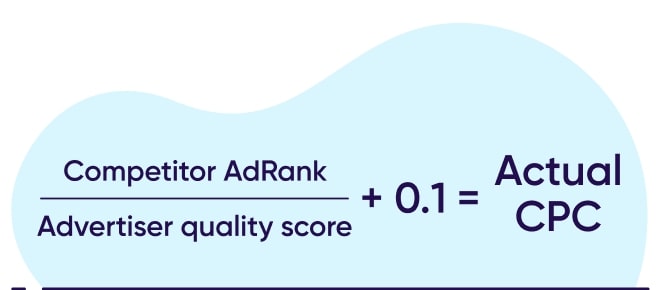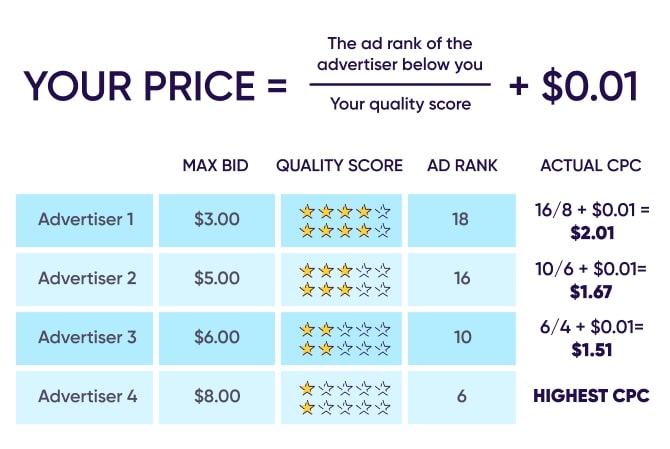Cost per click (CPC) is a term used in paid online advertising to demonstrate what an advertiser pays every time his/her ad receives a click.
What is CPC?
In a pay-per-click advertising model, advertisers pay the publisher (the party that owns the ad space) only when someone clicks on their ad. Your cost per click (CPC) is the amount you pay for each of those clicks.
With spending on digital advertising projected to reach 836 billion dollars by 2026, brands want to know their investment is paying off. Clicks are a good indicator that your ad has captured attention, so this model means you’re paying for action, rather than spending money on passive views.
Keeping track of your CPC is vital to get the most from your ad budget, but there are various factors that can influence it. Let’s find out how it works.
How to calculate CPC
You can calculate your CPC using the following formula:
Let’s look at an example.
Hotels.com decides to advertise in the British Airways app. Once someone has completed a flight purchase, they receive an ad offering them hotel deals in their destination of choice. Hotels.com paid British Airways $5,000 for their ad campaign, and received 20,000 clicks over the course of the campaign. This brings their CPC to $0.25.
Benefits of using CPC
CPC is one of the most widely used metrics — here are some of the reasons why.
1. Control your costs
The CPC model offers value for advertisers, because you only pay the publisher when your ad is actually clicked on. And you can set daily limits so that you don’t go over budget.
2. Understand ad performance
The number of clicks your ad receives is a good indicator of how well it’s performing. If it’s on the low side, you can quickly take action to change or stop the campaign, protecting your budget.
3. Focus on an engaged audience
Measuring clicks is important because, unlike impressions, they show a level of engagement from a user. This makes them a better indicator of intent which can lead to conversions further down the funnel.
4. Maximize your ROI
Pay-per-click campaigns are a big part of online marketing, so you want to get your money’s worth. Understanding what each click costs you, and making sure you don’t overpay, is vital to protecting your bottom line and getting a solid return on your marketing investment.
Challenges of using CPC
While CPC is certainly popular, it’s not all roses and there are some drawbacks to be aware of.
1. Costs can be high
If you manage to run a successful campaign with a high click-through rate, then you could see a large bill at the end of it — particularly if you’re using competitive search terms. Be sure to keep an eye on your campaign, your conversions, and your daily CPC budgets to make sure you stay profitable.
2. Clicks don’t mean conversion
Clicks do indicate interest, but they don’t always translate into paying customers. To boost your chances, make sure the content in your app or on your site is top quality. It should align with your advertising and clearly sell the benefits of your product, making it irresistible.
3. Every click counts (even if you don’t want it to)
With CPC, you don’t only pay for “good” clicks (users with a genuine interest in your brand). You’ll also pay if someone clicks by accident, or, worse, for fraudulent activity. If fraudsters repeatedly click on your ad, you’ll be charged but see no conversions in return.
How does CPC work?
Some campaigns have a fixed price per click, which is negotiated in advance between the advertiser and the publisher.
Alternatively, pricing can be based on a bid. Here the advertiser tells the publisher the maximum they’re willing to pay per click, and how many clicks they’re looking to achieve.
It then gets a bit more complicated. In Google Ads, for example, CPC is calculated as follows:
Let’s explain these new terms.
Quality score
Think of your quality score like a credit score. Just like your credit score will affect your ability to apply for a credit card, your quality score will affect your CPC.
Your quality score will depend on many factors, including:
- Keyword relevance
- Click-through rate
- Historical performance
- Landing page quality and relevance
The higher the bid and quality score, the more likely your ad will appear in front of the right audience. You CPC will never exceed your maximum bid. It may be the same or lower, but never more.
Ad rank
Ad rank is used to determine where on a search page your ad will appear (if at all). There are multiple factors that go into the ad rank, for example the quality of your ad at the time of auction, the bid amount, and your position relative to your competitors.
The price per click varies depending on the vertical. For example, keywords for legal services often demand the highest costs. Financial and other professional services like insurance aren’t far behind. That’s because there is a lot of competition for these keywords which are also relatively niche.
The price per click varies depending on your industry. For example, keywords for legal services often demand the highest costs, closely followed by financial and other professional services. That’s because there is a lot of competition for these keywords which are also relatively niche.
Your ad rank, quality score, and maximum bid combine to determine what the CPC will be.
CPC bidding strategy
If you’re bidding on search terms to generate clicks, you have two options: manual or automated bidding.
Manual bidding means you can fix your maximum CPC yourself. You can set a budget for each individual keyword, and adjust it as needed, giving you complete control. While this has its benefits, it can be time consuming and hard to scale up.
Automated bidding uses AI to take out the manual effort, setting bids for you based on your campaign goals. In Google Ads, for example, you can set targets like “Maximize clicks” or “Maximize conversions”. This approach saves you time and enables better audience segmentation and scaling than manual bidding. But it does require a good amount of historical data for the algorithms to be effective.
What’s an average CPC?
CPC varies hugely across verticals and formats. In 2023, the average CPC for Google Ads is $4.22. As mentioned earlier, ads for legal services cost much more (over $9), while in other industries it can be as low as $1.55.
Even among social media platforms the cost can vary significantly, with LinkedIn and Instagram typically more expensive than X (Twitter) and Facebook. There are various reasons for this: for example, LinkedIn has the advantage of reaching a targeted professional niche, while Instagram is keen to attract high-value advertisers prepared to pay a high CPM.
As always with social media, the best strategy is to know your audience and invest in meeting them where they are, rather than trying to be everything to everyone.
CPC vs other metrics
CPC shares similarities with various other marketing metrics. Let’s untangle some of the acronyms.
CPC vs CPM
CPM means cost per mille — in other words, the cost of displaying your ad 1,000 times (known as impressions).
CPM is often used when a brand wants to increase awareness and engagement. The focus is on visibility, rather than specific actions (such as clicks) which carry a higher cost. However, if your goal is to drive conversions then you’ll be more interested in your cost per click. The publisher may have to serve far more than 1,000 impressions to reach the desired number of clicks.
CPC vs CPA
CPA stands for cost per action, or sometimes cost per acquisition.
Isn’t a click an action? Well, yes. But CPA can cover various actions depending on your campaign goals, for example:
CPA is a target agreed between the advertiser and the publisher before the start of a campaign. Not to be confused with eCPA, which is the effective CPA and a measure of the actual results of the campaign.
CPC vs PPC
PPC stands for pay per click. If this sounds similar to cost per click, it’s because they’re two sides of the same coin.
PPC is a marketing campaign strategy, whereby marketers agree to pay a certain amount to the publisher whenever their ad is clicked on. (You can see this in action on Google, where the first few search results have the word “Ad” next to them.) CPC is used on the campaign measurement side, to show the cost to the advertiser of each individual click.
CPC vs CTR
CTR stands for click-through rate: the proportion of users exposed to an ad who actually click on it. Both metrics focus on clicks, but while CTR can indicate how well your ad is resonating with your audience, it doesn’t tell you anything about the cost.
CPC vs CPV
CPV stands for cost per view. If you’re running video ads, this lets you calculate the cost of getting one person to watch your ad to the end. Unlike CPC, this measures passive views rather than actions (clicks), making it more suited to awareness campaigns.
CPC vs CPI
CPI is your cost per install, a metric used in acquisition campaigns to calculate what you have to spend to win each new user. The more users you attract, the more effective your campaign and the lower your CPI. It’s similar to CPC in that they both involve users taking action, but ad clicks don’t always translate into those all-important installs.
CPC vs CPL
CPL stands for cost per lead. A lead isn’t a customer — yet — but they’ve expressed a definite interest in your service, for example by completing an online form. Whereas users might click out of curiosity, boredom, or just clumsy fingers, a lead has serious intent. CPL is most used for high-value subscriptions and professional services.
How to lower your CPC
Clearly, paying less for your clicks will benefit your budget. So how can you keep your CPC under control?
1. Improve your quality score
The fastest way to lower your CPC on search engines is to improve your quality score.
Typically, a higher quality score receives a lower CPC. Maintaining a quality score of 6 or higher can unlock discounts of 15 to 50%. Ensuring your ads are highly relevant and your landing page is top quality will help.
2. Continually refine your audience and keywords
As with any marketing, CPC is all about reaching the right audience. After all, the goal of the ad is to have them click through and progress towards converting.
Refining your audience and keywords helps you to be as specific as possible with your targeting. Cheaper isn’t always better — a higher-priced search term might deliver better results, but you may want to balance it with some lower-budget options. And remember to remove keywords that are no longer relevant or haven’t delivered the desired results.
3. Expand your reach
Through your keyword research, try to discover new and valuable avenues for clicks. You can also expand into new target audiences, geo locations, or advertising channels to try and expand your reach.
4. Adjust your bids based on key criteria
As part of ensuring your ads are properly targeted you can adjust your bids to focus on specific locations, time periods, and devices. Understand which combination of factors brings the best results and adjust your bids accordingly. In turn this will increase your quality score and further decrease your CPC.
5. Use A/B testing
For display ads, experiment with different versions of your creative to see which delivers the best results. An ad that drives more actions will be deemed more relevant, resulting in a lower CPC.
6. Prevent fraud
As mentioned earlier, click fraud can cost you dear. Google Ads has some safeguards in place, but you can always do more to stop your ad budget falling into the wrong hands.
Keep a close eye on your clicks and your budget — a flurry of clicks from the same IP address could signal someone up to no good, and you can have it blocked. Consider investing in a fraud protection tool to detect and block criminal activity across your mobile marketing campaigns.
Frequently asked questions
What is cost per click (CPC)?
CPC stands for cost per click, a model in pay-per-click advertising where advertisers pay the publisher a set fee each time someone clicks on their ad. Clicks indicate to an advertiser that their creative is capturing attention, and the CPC model ensures they’re paying for action rather than passive views.
How do you calculate CPC?
To calculate CPC, divide the total cost of your ad campaign by the number of clicks it received. For example, if an ad campaign cost $5,000 and received 20,000 clicks, the CPC would be $0.25. This formula helps advertisers understand the cost-effectiveness of their ad campaigns.
What are the benefits of using CPC?
The CPC model helps advertisers control costs by paying only for ads that attract clicks. It provides an insight into ad performance, allowing you to optimize campaigns, and lets you focus on an engaged audience. Understanding the cost of each click is also vital to protecting your bottom line and growing your ROI.
What challenges does CPC present?
While CPC can be effective, costs can be high if the campaign has a high click-through rate. In addition, not all clicks are equal: they don’t always lead to conversions, and you risk paying for unwanted or fraudulent clicks.
How does CPC work in advertising campaigns?
CPC can be fixed or bid-based. Advertisers can negotiate a fixed CPC with publishers or set a maximum bid they’re willing to pay per click. Google Ads, for example, uses a combination of bid amount and quality score to determine CPC and ad rank, affecting the ad’s visibility.
The average CPC varies significantly across different industries and platforms, with the average CPC for Google Ads in 2023 being $4.22. Costs can be higher for competitive keywords and lower for less competitive ones. Social media platforms also vary in cost, with LinkedIn and Instagram generally being more expensive than others.
How can you lower your CPC?
You can lower your CPC by improving your quality score, refining your audience and keywords, expanding your reach, adjusting bids based on key criteria, using A/B testing for display ads, and preventing fraud. These strategies can help make CPC campaigns more cost-effective.
Key takeaways
- In a pay-per-click advertising strategy, CPC tells an advertiser how much they’re paying the publisher every time a user clicks on their ad.
- CPC can be fixed, or you can set it by bidding. Bidding may be manual (where you set keywords yourself) or automated (based on AI).
- Clicks are a good indicator of engagement, so you’re paying for a relevant audience. CPC enables you to keep an eye on costs and protect your ROI.
- That being said, clicks don’t always lead to conversions, and they can be vulnerable to fraud. Keep an eye on your daily budgets to ensure you stay profitable.
- Average CPC varies greatly depending on your industry and the platform you’re using. Figures tend to be highest for professional services, where keyword bidding is very competitive.
- CPC shouldn’t be confused with other marketing metrics, such as CPM (which is useful for awareness and engagement) or CTR (which indicates the effectiveness of your creative).
- To lower your CPC, try to improve your ad’s quality score. Refining your audience and keywords, expanding your reach, and regularly adjusting your bids will also help — and always be alert to fraud.

